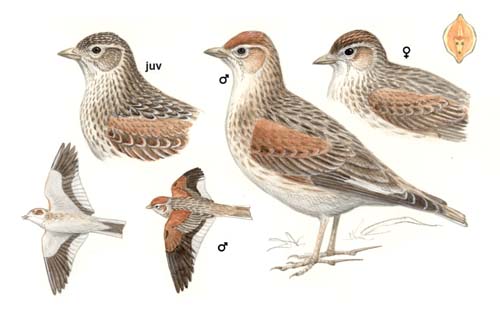
Passeriformes Alaudidae White-winged Lark (Melanocorypha leucoptera)
[order] Passeriformes | [family] Alaudidae | [latin] Melanocorypha leucoptera | [UK] White-winged Lark | [FR] Alouette leucoptère | [DE] Weißflügellerche | [ES] Calandria Aliblanca | [IT] Calandra siberiana | [NL] Witvleugelleeuwerik
Close in size to Calandra Lark but with more attenuated silhouette, due to relatively longer, even slightly forked tail; 15% longer and much bulkier than Snow Bunting (with which confusion possible). Upperparts chestnut on crown (paler on ) and juvenile) and wing-coverts; underparts essentially white with streaked chest and flanks. Flight feathers black, contrasting with thick white trailing edge above and also with white underwing coverts below. In flight, shape and action recall Skylark as much as Calandra Lark.
| wingspan min.: |
33 |
cm |
wingspan max.: |
37 |
cm |
| size min.: |
18 |
cm |
size max.: |
19 |
cm |
| incubation min.: |
12 |
days |
incubation max.: |
13 |
days |
| fledging min.: |
9 |
days |
fledging max.: |
10 |
days |
| broods: |
2 |
|
eggs min.: |
3 |
|
| |
|
|
eggs max.: |
5 |
|
Melanocorypha leucoptera breeds in south-eastern European Russia, but winters more
widely in the steppe region to the north and west of the Black Sea, with Europe
constituting >50% of its global wintering range. Insufficient information was available
to assess the species’s status using wintering population data, but its European breeding
population is relatively small (<65,000 pairs), and was stable between 1970-1990.
Although it fluctuated markedly during 1990-2000, the population remained broadly
stable overall, and consequently the species is provisionally evaluated as Secure.
No sound impression of White-winged Lark
In continental warm arid middle latitudes, lowland and to some extent upland, avoiding rocky and mountainous, forested, and wetland areas, and those humanly settled or much disturbed, although sometimes overlapping cultivation, especially on migration or in winter. Tolerates saline soils, but also lives on sand, clay, gravel, and sometimes on dark earth. Prefers vegetation neither tall nor dense.
Insects and seeds in summer, seeds in winter.
Laying starts late April, continuing to mid-July; most eggs laid in May. 1-2 broods. Nest is built on ground, usually well-concealed and sheltered by tussock or other plant. The nest is a shallow scrape, lined with carelessly woven basket of vegetation.
The eggs are sub-elliptical, smooth and glossy; very variable¾whitish, pale green, or pale yellow, variably speckled and spotted olive, grey-brown, and grey, usually with ring of spots at broad end. Clutch: 5-6 (4-7) incubated for 12 days. Fledging period is unknown, but young leave nest still unable to fly.
This species has a large range, with an estimated global Extent of Occurrence of 1,000,000-10,000,000 km2. It has a large global population, including an estimated 20,000-65,000 breeding pairs in Europe, in south-eastern European Russia, which accounts for only a small part of its global breeding range1. Interpretation of the limited available information on population trends is complicated by large interannual fluctuations in distribution5. The European population was stable during 1970-1990 and fluctuated by 30-50% during 1990-20001. In neither period was sufficient information available to assess the species’s population trends using wintering data. In parts of the Kostanay region (northern Kazakhstan), where the species was once widespread and numerous, its distribution and abundance have decreased noticeably over the past 25 years. It may still be more common than Black Lark M. yeltoniensis in this area, but it seems to have undergone an even greater decline than its congener, and reports suggest that this situation may be mirrored across Kazakhstan. However, in other areas of north-central Kazakhstan, the species was relatively common in 2005, especially in the shorter steppe vegetation, and also remains common in wormwood semi-deserts to the east of the Lower Volga. In summary, in Kazakhstan, the species appears to have a relatively stable population and is common in suitable habitats (although not dispersed evenly, with empty areas). In wintering areas in Uzbekistan, numbers are weather-dependent, but generally stable. Overall, the species is not believed to approach the thresholds for the population decline criterion of the IUCN Red List (i.e. declining more than 30% in ten years or three generations). For these reasons, the species is evaluated as Least Concern. (source Birdlife.org)
Short-distance migrant, mainly within FSU. Birds flock in midsummer, when breeding completed, and some movement begins then. Exodus protracted, and some birds still present in southern Urals in December; however, main passage occurs mid-August to October. Return movement proceeding in March; southern areas reoccupied by mid-April, though in northern parts main arrivals in late April or even early May.
Distribution map breeding season



